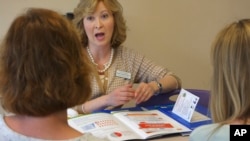A phone app is helping doctors have difficult conversations with patients about lowering doses of opioids.
Primary care doctors prescribe nearly half the opioids dispensed in the U.S. They're increasingly being called upon to stem the flow of the highly addictive pills into medicine cabinets. That means writing lower-dose or shorter-term prescriptions for some patients, helping others taper off high doses and refusing opioids entirely to others.
The shift enrages some patients.
"People will blow up. We have to call security. They can get very mean," said Dr. Ashley Ruby, a Philadelphia family physician.
U.S. public health officials developed an app to help doctors practice a technique called motivational interviewing. It's part of the Centers for Disease Control and Prevention's opioid guidelines app, which also has a dosage calculator and a copy of the first national prescribing guidelines.
The app, released in December, includes these tips for doctors:
— Ask open-ended questions. This increases the patient's involvement in the discussion and allows for more meaningful conversation. For example: "What are some of your goals as we manage your pain?"
— Reflect. Reflective listening helps the patient feel understood. For example: "It sounds like you miss being able to play with your grandchildren."
— Express empathy. "A lot of people are concerned about managing their pain if the amount of opioids is decreased."
— Evoke "change talk." "What would you like to see different about your life right now?"
— Develop discrepancies. Help patients see the difference between their current behavior and their goals. "You've told me that exercise helps you have more energy and reduces stiffness. Why do you think it's been hard for you to get more active?"
— Provide affirmation. "I am glad to see your endurance is improving with physical therapy. Keep it up!"
In the app, doctors can try a hypothetical conversation with a virtual patient. Red messages (which indicate the doctor should "try again") or green messages (which indicate a correct response) pop up after the doctor picks what to say next.








